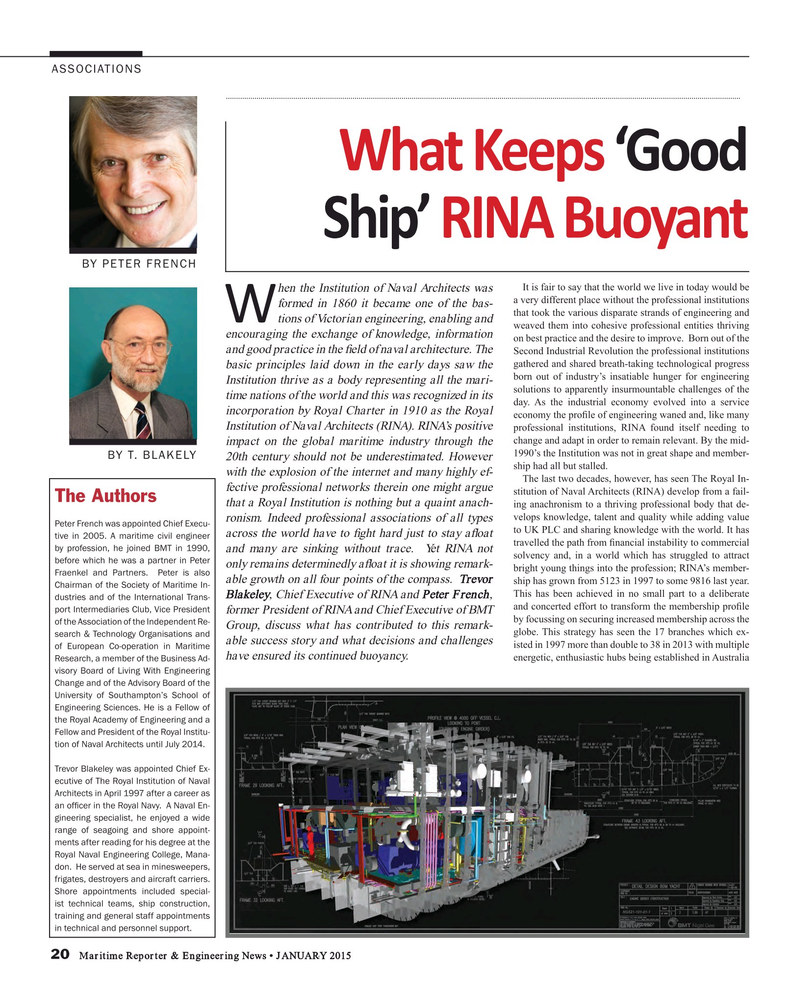
Page 20: of Maritime Reporter Magazine (January 2015)
Ship Repair & Conversion Edition
Read this page in Pdf, Flash or Html5 edition of January 2015 Maritime Reporter Magazine
ASSOCIATIONS
What Keeps ‘Good
Ship’ RINA Buoyant
BY PETER FRENCH
It is fair to say that the world we live in today would be hen the Institution of Naval Architects was a very different place without the professional institutions formed in 1860 it became one of the bas- that took the various disparate strands of engineering and
Wtions of Victorian engineering, enabling and weaved them into cohesive professional entities thriving encouraging the exchange of knowledge, information on best practice and the desire to improve. Born out of the and good practice in the ? eld of naval architecture. The
Second Industrial Revolution the professional institutions gathered and shared breath-taking technological progress basic principles laid down in the early days saw the born out of industry’s insatiable hunger for engineering
Institution thrive as a body representing all the mari- solutions to apparently insurmountable challenges of the time nations of the world and this was recognized in its day. As the industrial economy evolved into a service incorporation by Royal Charter in 1910 as the Royal economy the pro? le of engineering waned and, like many
Institution of Naval Architects (RINA). RINA’s positive professional institutions, RINA found itself needing to change and adapt in order to remain relevant. By the mid- impact on the global maritime industry through the 1990’s the Institution was not in great shape and member-
BY T. BLAKELY 20th century should not be underestimated. However ship had all but stalled.
with the explosion of the internet and many highly ef-
The last two decades, however, has seen The Royal In- fective professional networks therein one might argue stitution of Naval Architects (RINA) develop from a fail-
The Authors that a Royal Institution is nothing but a quaint anach- ing anachronism to a thriving professional body that de- velops knowledge, talent and quality while adding value ronism. Indeed professional associations of all types
Peter French was appointed Chief Execu- to UK PLC and sharing knowledge with the world. It has across the world have to ? ght hard just to stay a? oat tive in 2005. A maritime civil engineer travelled the path from ? nancial instability to commercial by profession, he joined BMT in 1990, and many are sinking without trace. Yet RINA not solvency and, in a world which has struggled to attract before which he was a partner in Peter only remains determinedly a? oat it is showing remark- bright young things into the profession; RINA’s member-
Fraenkel and Partners. Peter is also able growth on all four points of the compass. Trevor ship has grown from 5123 in 1997 to some 9816 last year.
Chairman of the Society of Maritime In-
This has been achieved in no small part to a deliberate
Blakeley, Chief Executive of RINA and Peter French, dustries and of the International Trans- and concerted effort to transform the membership pro? le port Intermediaries Club, Vice President former President of RINA and Chief Executive of BMT by focussing on securing increased membership across the of the Association of the Independent Re-
Group, discuss what has contributed to this remark- globe. This strategy has seen the 17 branches which ex- search & Technology Organisations and able success story and what decisions and challenges isted in 1997 more than double to 38 in 2013 with multiple of European Co-operation in Maritime have ensured its continued buoyancy.
energetic, enthusiastic hubs being established in Australia
Research, a member of the Business Ad- visory Board of Living With Engineering
Change and of the Advisory Board of the
University of Southampton’s School of
Engineering Sciences. He is a Fellow of the Royal Academy of Engineering and a
Fellow and President of the Royal Institu- tion of Naval Architects until July 2014.
Trevor Blakeley was appointed Chief Ex- ecutive of The Royal Institution of Naval
Architects in April 1997 after a career as an of? cer in the Royal Navy. A Naval En- gineering specialist, he enjoyed a wide range of seagoing and shore appoint- ments after reading for his degree at the
Royal Naval Engineering College, Mana- don. He served at sea in minesweepers, frigates, destroyers and aircraft carriers.
Shore appointments included special- ist technical teams, ship construction, training and general staff appointments in technical and personnel support. 20 Maritime Reporter & Engineering News • JANUARY 2015
MR #1 (18-25).indd 20 MR #1 (18-25).indd 20 1/7/2015 9:52:14 AM1/7/2015 9:52:14 AM

 19
19

 21
21
